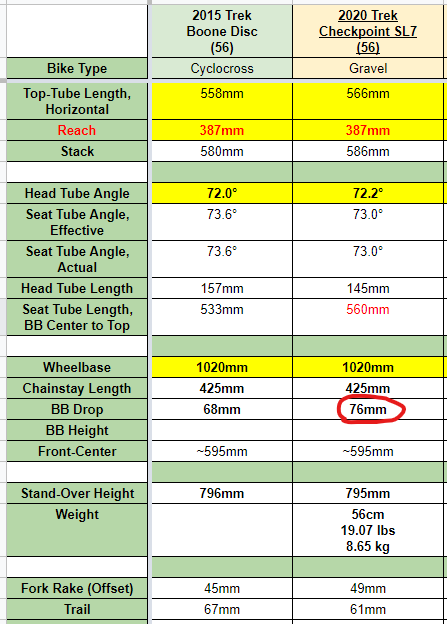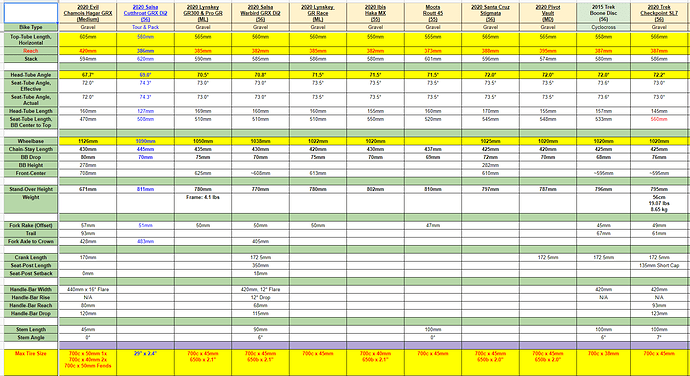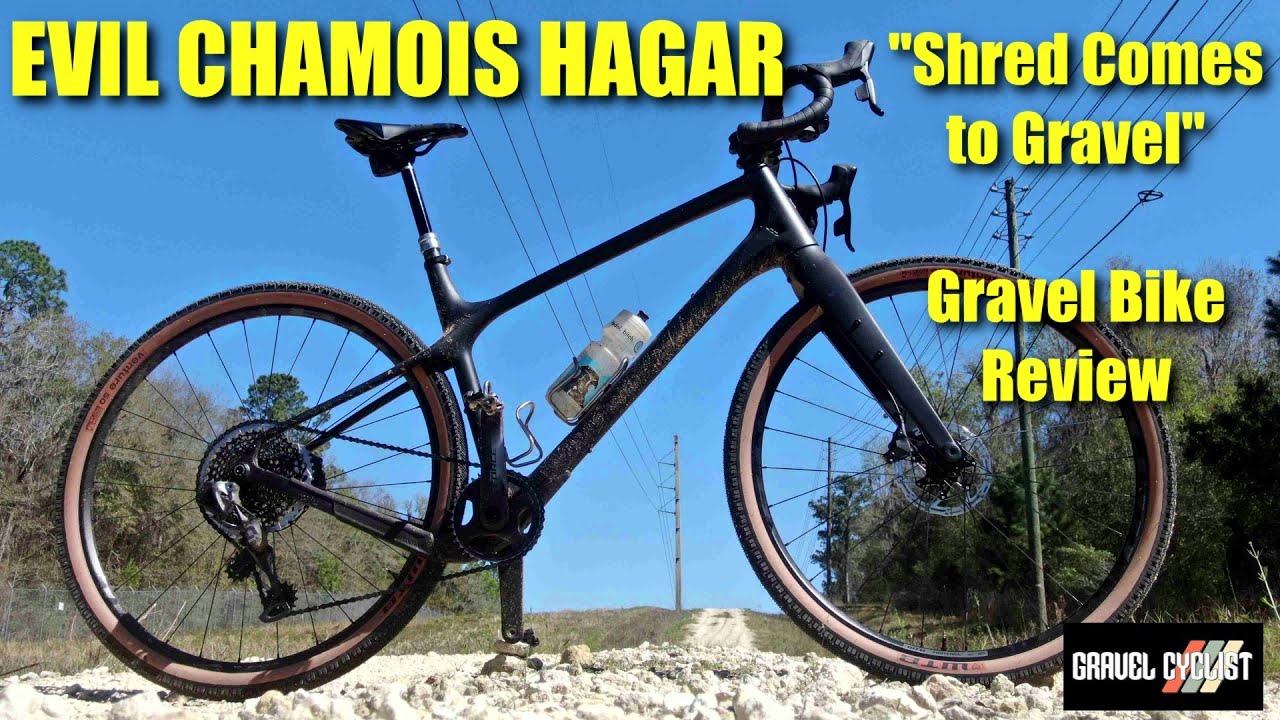Yeah, there is no intent (implied or direct) stated about using the CH for CX. It is a pure gravel bike, with heavy bias towards stability, that is the antithesis of what is needed for CX.
I wonder if they could have made it more aero. Shape of the tubes, etc. That would help with long gravel events, sort of a TT bike for gravel. Long and low used to be a trend in TT, maybe there’s a place for it in gravel events.
I’m not sure what the point of the dropbar is. If you want stability and control, a flat bar would be better. If you want to be more aero, you’d want to limit the width of the bars, but that doesn’t help with control. You can obviously also just put your hands closer to the stem on flat bars, like xc riders do. But then, the drops create additional drag you don’t want.
To be honest, I think the market for this isn’t serious racers, it’s the recreational riders that want to look cool. So performance discussions are missing the point.
It’s certainly a head turner. Which I’m sure is part of Evil’s goal.
I would love to get Sala’s take on this bike seeing as they were the first major brand to bring a “gravel bike” to market and the Chamois Hagar looks like a mix between the Cutthroat and a MTB. There must be a reason Salsa hasn’t felt the need to promote the Cutthroat toward the gravel racing scene. Probably for good reason.
It looks less like what I want a gravel bike to be (Trek Crockett or any large tire clearance CX bike) and more like a dirt drop single track all-mountain shredder. No doubt probably a ton of fun, but I don’t know why anyone would buy this for Kanza, and other non-tech gravel racing. It seems like way too much bike.
This isn’t about the Hagar in particular, but can anyone tell me how much a small change in head angle affects a bike like this?
I don’t have a gravel bike, but I race a lot (a lot) of cross. I was thinking that the ideal gravel bike would be just a bit slacker than my CX race bike, maybe ~69 degrees. That would open things up on the descents a bit and still keep it as a ripper on the road. But I just looked up a much of measurements (Specialized, Salsa, Cannondale, Trek) and they are all just about the same as my CX bike (71-72 degree head angle). The Trek Checkpoint is actually steeper than my Trek Boone and has the same wheelbase!
So what gives? I always hear things like ‘gravel bikes need to be stable on long sweeping high speed turns’, etc, etc. I understand that the Evil is an extreme example, but it seems like these other bike are basically just heavy cross bikes.
Head Tube Angle (HTA) is just one of several numbers that help determine how a bike will handle.
That combined with the Fork Rake / Offset create a Trail value. That can indicate how snappy the steering may be. I say may because you also have to look at things like Wheelbase, Chainstay Length and Bottom Bracket (BB) Drop all add into the geometry soup.
Quickly, in the Boone vs Checkpoint, the are really close in most dims, but even with the steeper HTA, the BB Drop on the CP will likely give it a more “in the bike” feel in most situations. Additionally, the CP has adjustable rear dropouts, so you can lengthen the overall Wheelbase and Chainstay Length, to add more stability. I don’t remember where my data is, but I think it is in the middle of the 20mm adjustment (IIRC), so you could stretch it another 10mm in most of those dims (ignoring the loss to vertical height deltas).
Here are some bikes in the category sorted from slack to steep HTA for reference. Check all the data to see the full idea of handling:
Very interesting, thanks for the data!
Gravel bikes are kind of a marketing trick. Most of them derived from the manufacturers CX frameset(s) and were given very minor geo tweaks and occasionally different groupsets. By and large, the same bikes.
I think we’re splitting hairs here when we talk like a half a degree of rake or 10mm of wheelbase is going to make a notable difference. It’s probably not for the vast majority of riders. But marketing is powerful and many people will buy into the manufacturers claims.
I do think some of the newer “gravel” bikes like the Topstone are doing interesting things with their “suspension” that’s probably something that can be felt over miles of gravel.
While geometry between CX and gravel share more than they differ on many brands, one big difference that has begun to separate them more is pure tire clearance. Some brands initially started by opening their CX bikes up past the 35mm max that was common (as based on the UCI 33mm width limit).
Specialized and others initially setup their CX bike as the Gravel option by doing so. But as they made Gravel specific models, they were able to do 2 things:
- Return the CX bikes to more narrow tire max, to keep the bikes lighter and race focused.
- Push the Gravel bikes to wider and wider tires, even allowing for 650b setups in some cases. This combined with more consideration and accommodation for extra bottles, packs and other “gravel” features that would NOT be welcome on a CX race bike.
So, there are similarities for sure, especially on the older models. But as the Gravel bike evolves into something more distance focused for carrying and getting more aggressive rubber, they are losing at least some of the direct connection from their CX roots.
Good call. My 2020 Boone has much tighter clearance than my 2015 Boone. I just got the new one; I’m going to use the 2015 for gravel and as the world’s best pit bike during the season. I believe I can get close to 40mm in there. I was contemplating trying to find a used gravel bike, but was looking at the geo charts and thinking, ‘Ummmm…looks the same.’
Yup, that and the latest Spesh Crux did that. I suspect other brands have done the same. CX is pure CX for many brand models now. However, there are surely some that are making double-duty bikes that blur the lines, so we are likely to have options on either end and in between for some time.
And lower BB heights as well on true Gravel bikes. A significant difference.
The idea that CX and Gravel bikes aren’t largely the same is about 3 years old…gravel bikes have evolved considerably since then into their own genre.
This is a big one. BB height on gravel bikes is getting very, very low and drop is exceeding road bikes in some cases.
I’m currently in the market and there seems to be a lot of gravel frames that are more off road leaning in many ways, but then limited in technical terrain (or in ruts/off cambers on the cx) course by a very low bb and the probability of pedal strikes. Good for racing on rough open roads for long races though.
Keep in mind that the BB drop is relative to the axles. With the larger tire sizes, this raises the entire bike. So an apparent 10mm delta between a CX and Gravel is partly offset by the tire size. It likely won’t make them equal, but it can cut that in half in some cases.
Also, as we’ve seen in MTB, I expect to see lobb and shorter cranks combine to get low center of mass and maintain more crank clearance.
Very true. Gravel bikes of the latest vintage have definitely moved the needle from their CX derivatives. With regards to tire-clearance, my 2019 Trek Crockett can fit 700x43c tires front and rear. I still love a CX frame for gravel racing, but that might change as I get older.
I do think things like conditions, tire choice and pressure can have as big an effect on a bike’s handling as its geo. Simply put, gravel geo doesn’t necessarily mean the bike is certain to handle better. Still a lot of rider input and other factors that impact how a bike handles. If one has budget for a gravel bike I think it’s money well spent though.
Agree on all points, well said ![]()
Awesome! I’ve been waiting for these read outs.
Seeing how chattery this bike was, it’s definitely not the bike for me, but kudos to Evil for trying something different!




